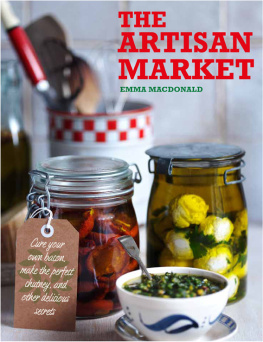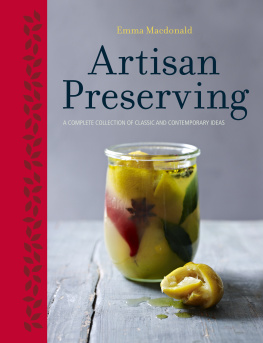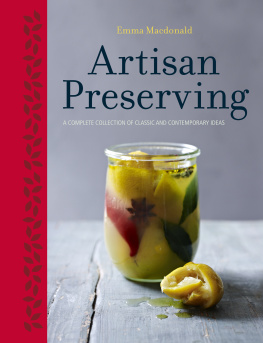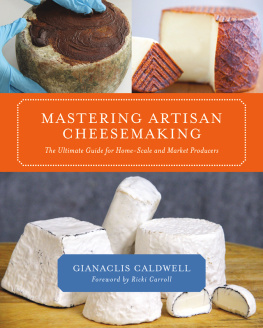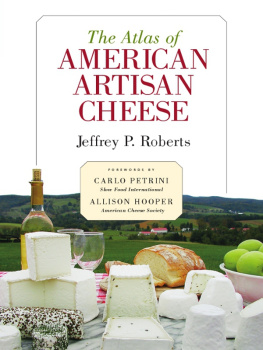THE
ARTISAN
MARKET
EMMA MACDONALD

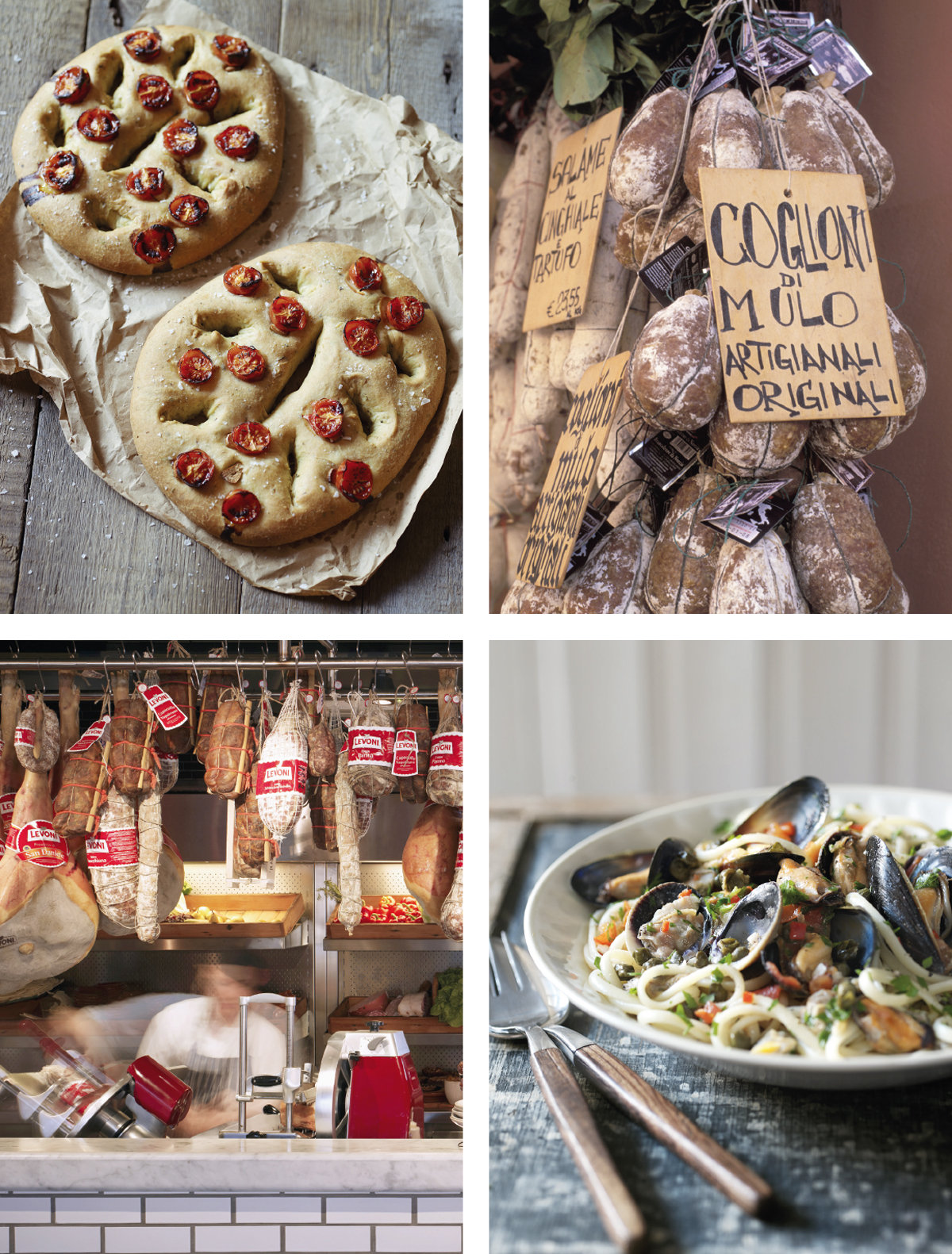
FOREWORD
After almost twenty years in the food business, a great wish of mine has been to publish my own cookbookand now here it is, The Artisan Market, a collection of my favorite deli secrets, and so much more.
From the age of thirteen I wanted to make a career in cooking and I spent much of my free time devising new recipes and baking cakes for friends and family. I studied catering in college and, after finishing, I worked as an apprentice in a number of restaurants in France before traveling through Asia, working in various restaurants and catering establishments as I went. This was a great way of learning to appreciate different cultures, ingredients and styles of cooking. In Asia, I discovered the eclectic mix of spices sold in markets and how they are used in cooking, along with the techniques that make Asian cuisines so fresh and vibrant. This has influenced my own style of cooking, especially in the way I like to add a fresh interpretation to classic recipes in our Bay Tree condiments.
I grew up in a house where there was always a supply of homemade jams and chutneys, so it seemed a natural progression to start making my own, and, in time, I decided to make a living from it. I established The Bay Tree Food Co. in my early twenties, producing traditional, home-cooked condiments and marmalades with a modern twist. More recently, we have moved into creating home-style ready-made sauces and pasta sauces. One of our greatest early successes was AGA-dried tomatoes, but, unfortunately, the demand far outweighed the volume we could make at the time. So we then set our sights on what could be done without sacrificing our desire to create high-quality products without any artificial additives.
It hasnt always been plain sailing, and I quickly found that making products in a jar with a good shelf life (as opposed to making a meal to be eaten right away) requires a certain amount of food science, but this aspect has also always fascinated me. Recognizing and appreciating that fresh produce can vary in taste, texture or color, depending on the season, weather and growing conditions, and using this knowledge, can make such a big difference to the end product. I always aim to make products as close as I can to the home-cooked equivalent without compromising on flavor and texture, or having to add artificial additives, while also offering the convenience of a product with a good shelf life.
The recipes in this booklike The Bay Tree productsare predominantly based on a traditional theme, but with an exciting twist. My recipe for gravlax (see ), for example, features fresh lemon and gingerroot to flavor the salmon, instead of the more classic dill. I also hope youll try making pts, preserves, sauces and even some home-smoking. If this doesnt appeal to you, there are also recipes that use these ingredients bought already prepared from a deli for those times when you want to make a mouthwatering meal quickly. Some recipes are simple and others demand more effort, but either way the end results are worth it!
Ive also included recipes for some of our popular Bay Tree products, such as Piccalilli (see ). You can also create this recipe with a store-bought piccalilli. Homemade condiments, jams and sauces are such a treat to have in the kitchen and are a delight to give to family and friends. The fact that they are so appreciated and enjoyed makes the effort more than worthwhile.
I hope youll enjoy these recipes and find the time to be creative making your own deli products, as well as using the ready-made ones in the recipes.

Contents
COOKING THE BAY TREE WAY
A good deli is a fantastic treasure trove of culinary delights, from cured meats, smoked fish and sweet preserves to artisan cheeses, fresh pasta and hand-crafted savory pies.
This book is designed to be both accessible and inspiring, featuring a collection of recipes for dishes that incorporate deli foods you buy and also more challenging recipes, showing how you can create your own deli products at home, such as home-cured bacon, ricotta cheese, fresh pasta, flavored vinegar, seafood pt and artisan breads. There are also suggestions for how to give classic deli foods an interesting new spin, such as a crab terrine that forms the filling of a creamy seafood tart (see ). Whether you buy your deli products or make them from scratch, theres a wonderful variety to choose from.
MEAT & POULTRY
While the French term charcuterie might traditionally have meant pork products, it has become a generic word encompassing all manner of cured and preserved meats from all over the world. Pork still reigns supreme in the world of charcuterie, however, thanks to its incredible versatility: just think pts, terrines, bacon, salami, sausages, ham and savory pies.
Arguably the finest and most expensive ham is the Spanish jamn Ibrico. The Ibrico pig roams freely and spends its final months in oak forests feeding on acorns (bellota), which give the meat a unique delicate, sweet flavor. The curing process that follows takes at least twelve months and up to thirty-six months, to produce a ham with melt-in-the-mouth qualities. Salt-curing draws out the moisture in meat, thus intensifying the flavor and firming up the texture. It also inhibits the growth of harmful bacteria. You can try salt-curing with the recipe for Home-Cured Bacon (see ), which is immensely satisfying and rewarding to make.
Gameboth feathered and furredis becoming more widely available and is enjoying a resurgence in popularity. Rabbit, pheasant, partridge, squab pigeon and venison are perfect for savory pies, pts, terrines and potted meats, but because they are low in fat you usually need to combine them with a fattier meat, such as duck or pork, to keep them moist. Its the generous fat content that makes duck and pork perfect for rillettes, potted meat, confit and pts. When youre making meat pts, try duck, goose and chicken livers, which are not expensive to buy and create a great base flavor.
FISH & SHELLFISH
Fish and shellfish can be smoked, salted, cured or pickled, but if you intend to preserve your own seafood, the key is to use the freshest you can buy.
Home-smoking is growing in popularity. Home-Smoked Trout (see ) is easy to make so is a great starting point. The fish is hot-smoked, which cooks it while imparting a delicate smokiness. You dont need any special equipment; I use an old wok, but a sturdy cracker tin, or galvanized garbage pan if smoking on a larger scale outdoors, work well, or you can invest in a purpose-built hot-smoker.
In contrast, cold-smoking is a much longer, slower process. It does not cook the food, but gives it a much more intense smokiness than hot-smoking, and it also extends the shelf life of the fish, which is cured before smoking. Cold-smoking requires investment in specialist large pieces of smoking equipment, so is probably out of the scope of most home cooks. But cold-smoked fish is widely sold. Salmon is probably the most popular cold-smoked fish, but look for sturgeon and mackerel, too, both of which are delicious when sliced very thinly and served on rye bread with pickled cucumber or a spoonful of cucumber relish, or with blinis and sour cream or crme frache. Other smoky delights include smoked mussels and oysters, herring (kippers) and eel.

